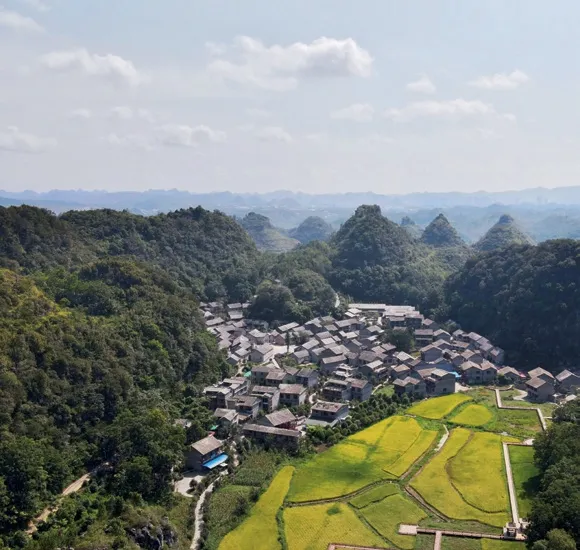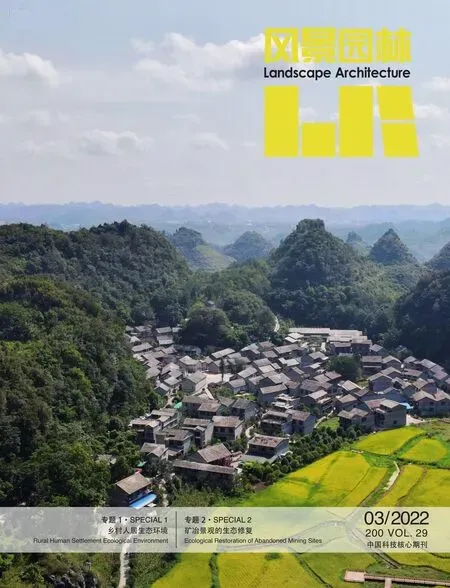乡村人居环境

尽管全球正在经历普遍的、广泛的城市化,乡村依然是人类聚居的基本环境类型。2020年全球总人口达76亿,其中有约34亿人居住在乡村。相比于高度人工化的城市地区,全球乡村面积更为广阔,人居环境与自然环境的关系更为密切。乡村聚落及所依附的农耕、渔业、林业等蕴含着丰富的传统营建智慧和本土景观特色,同时乡村人居环境的统筹发展是国土空间生态系统治理的重要内容,具有很高的研究价值。
不同地域文化孕育不同乡村景观,每个国家都有值得认知和研究的乡村传统生态智慧。菲律宾北部伊富高(Ifugao)省宏大的高山梯田是举世闻名的古代奇迹。它是当地土著部落人民为了谋生而在裸露的山地上开垦出的田地,田地依等高线沿陡峻的山坡构筑,围以石墙,呈梯状,顶部向内微有倾斜,以使灌溉之水得以储存发挥效益。这些梯田过滤和净化了山顶热带松林中的雨水,造福了当地的村庄和下游的主要城市。高山梯田是村落与森林、稻田、水系相协调的人居生态体系,也是文化与生物多样性相适应的国土空间治理模式。
自古以来中国乡村的营建往往与自然环境融为一体,构成一幅幅美丽的山水画卷。元代黄公望的《富春山居图》描绘了富春江流域依山水而居的乡村风貌,画中富春江贯穿于两岸丘陵之间,江中分布大小沙洲,沿江则展现出沃野良田、阡陌交通的景观。流域内的聚落依所处地貌环境,分布在沿江平原、沙洲及丘陵山地上,并形成了应对水患顺应地势的农耕模式。《富春山居图》蕴含了农业生产、聚落营建与山水环境相互适应的人与自然共生思想。今天,在富春江沿岸仍存在着如画中所描绘的乡村景观风貌,在滨水区及江中沙洲上的耕作田地外围用土石等材料修筑堤坝或围堰,以阻挡洪水侵袭,堤上设闸以灵活控水、排水,从而形成圩田。汲取地域传承的乡村营建智慧,对自然进行循序渐进的人工干预,这在当下乡村人居环境发展中仍具有现实意义。
当今面临的气候变化、全球生态环境恶化等普遍问题为乡村人居可持续发展带来挑战,风景园林学科在乡村人居环境研究和实践中发挥着重要的作用。首先,乡村人居环境是一个社会–生态的复合系统,孕育于广阔的山水环境中。在国土空间规划的背景下,乡村人居环境整治需要树立系统观念,将全域自然生态空间与乡村人居体系的规划融为一体,促进生态空间的整治和修复、生产空间的复合与多元、生活空间的集约与高效,从而划定乡村空间发展的一张蓝图。其次,乡村人居环境应当是宜居宜业的美好家园。在以全域生态系统考虑的前提下,需要完善传统乡村人居环境评价体系和流程,指导修复、重建和优化生态系统网络,为乡村合理的生产生活及建造活动提供科学支撑,创造出适合人类使用、生态平衡健康且具有美学价值的乡村人居。再者,乡村人居环境是文化传承的重要载体。新时代归园田居不应是去孤独地株守每个空心化的村庄,也不应是简单地还原乡村从前的模样,而是要把从人类文明中吸纳的现代精神,与从乡土文化中汲取的传统营养融合起来,塑造崭新的乡村人居形态,推进乡村传统人居生态智慧的创造性转化,在实践中丰富新时代乡土语境下的规划设计理论及实践,解决乡村特色淡化、乡土价值遗失的问题。最后,以风景园林的技术手段植入乡村人居生态环境营造,因地制宜,挖掘乡村原生特色和潜在价值,唤醒乡村地域本色和内生性动力,重塑生态生产相融合的绿色产业,打造最普惠的民生福祉,推进乡村经济高质量发展。
风景园林学科在乡村人居环境领域的实践与创新,既是新时代推进乡村全面振兴的内在要求和关键支撑,更是深刻把握我国乡村特征和响应新时代国家发展需求的必然选择。

Rural Living Environment
The world being urbanized generally and widely, the rural area still remains as the basic type of human in-habitation, with approximately 3.4 billion people living in the rural area out of a total global population of 7.6 billion in 2020. As against the highly artificial urban areas, the global rural area is much more extensive and the living environments are more closely related to the natural environment. There are rich traditional wisdom and local landscape features in rural settlements and their dependent farming, fishery and forestry, and the overall development of rural living environment is an important part of spatial ecosystem management, with a high research value.
Different rural landscapes arise out of different regional cultures and each country is provided with its own rural traditional eco-wisdom worthy of cognition and research. As one of the world-renowned ancient wonders, the magnificent alpine terraces in Ifugao of northern Philippines are the fields reclaimed by the local indigenous tribesmen in the bare mountains for a living. These fields,constructed along steep slopes along contour lines and surrounded by stone walls, are in the shape of terraces, and with the tops sloping slightly inward to allow irrigation water to be stored and used efficiently. These terraces filter and purify rainwater from the tropical pine forests at the top of the mountains, bringing benefit to the local villages and the major cities downstream. Not only are the alpine terraces are a habitat ecosystem where villages are in harmony with forests, rice fields and water systems, but also a governance model of national land space in which culture and biodiversity are compatible.
Since ancient times, the rural construction in China has often conflated the natural environment, forming a beautiful landscape painting.Dwelling in the Fuchun Mountains, a painting by Huang Gongyuan of the Yuan Dynasty, depicts the rural style of living by mountains and rivers in the Fuchun River basin. In the painting,the river runs through the hills on both riverbanks, sandbars are distributed in the river, and fertile fields and links paths appear along the river. According to their geomorphic environment, the settlements in the watershed spread on the plains, sandbars and hilly areas along the river, and have formed a farming model responding to flooding and conforming to the terrain. This painting entertains the idea that agro-production, settlement construction and landscape environment are adapted to one another and that man and nature coexist. Today, the rural landscape as depicted in the picture continues in this area. Dikes or weirs are constructed with earth and stones on the periphery of farming fields on the waterfronts and sandbars in the river to resist water intrusion. The dikes are equipped with gates to flexibly control and drain away water, thus forming polders. It is still of practical significance in the present development of the rural living environment to draw on the wisdom of rural construction inherited from the region and make an artificial intervention in nature step by step.
The sustainable development of rural living environment has risen to the challenge from such common problems we face today as climate change and deterioration of global ecological environment,and the landscape architecture discipline importantly functions in the study of rural living environment. First of all, as a socio-ecological combined system, rural living environment exist in a vast landscape environment. In the context of territorial spatial planning, it is needed in the renovation of rural living environment to have a system idea and combine the whole natural eco-space with the planning of rural living environment system to facilitate the improvement and restoration of ecological space, the recombination and diversification of production space, and the intensification and efficiency of living space, so as to draw up a blueprint for the spatial development of the rural area. Secondly, rural living environment should become a beautiful home that is livable and workable. On the premise of considering the whole ecological space, it is necessary to optimize the appraisal system and process of traditional rural living environment,conduct the restoration, reconstruction and optimization of the ecosystem network and scientifically back up the reasonable activities related to production, living and construction in the rural area so as to create rural living environment suitable for human use,balanced and healthy in ecology, and provided with aesthetic value.Furthermore, rural living environment is an important carrier of cultural inheritance. Returning to nature in the new age should not to guard each empty village alone, nor to simply restore the former appearance of the rural area. Rather, we should mix together the modern spirit absorbed from human civilization and the traditional essence drawn from the indigenous culture to shape a new form of rural living environment and boost the creative transformation of the traditional ecological wisdom for rural living environment. Besides,the theory and practice of planning and design in the local context of the new age should be enriched in practice to solve the problems related to weakening of rural characteristics and loss of rural area value. Finally, the technical means of landscape architecture should be used in the construction of rural living environment and ecological environment. The local conditions should be followed in exploring the native characteristics and potential values of the rural area and generating the regional natural features and endogenous power of rural area to improve the well-being of the people and advance rural economy with high quality by booming the green industry integrating ecological production.
Not only is the practice and innovation of landscape architecture discipline in rural living environment the intrinsic requirements and crucial brace in promoting the comprehensive revitalization of the rural area in the new era, but also the inevitable choice of the discipline in deeply grasping the characteristics of China’s rural area and responding to the national development needs in the new era.
Editor-in-Chief: Professor ZHENG Xi
February 23, 2022

